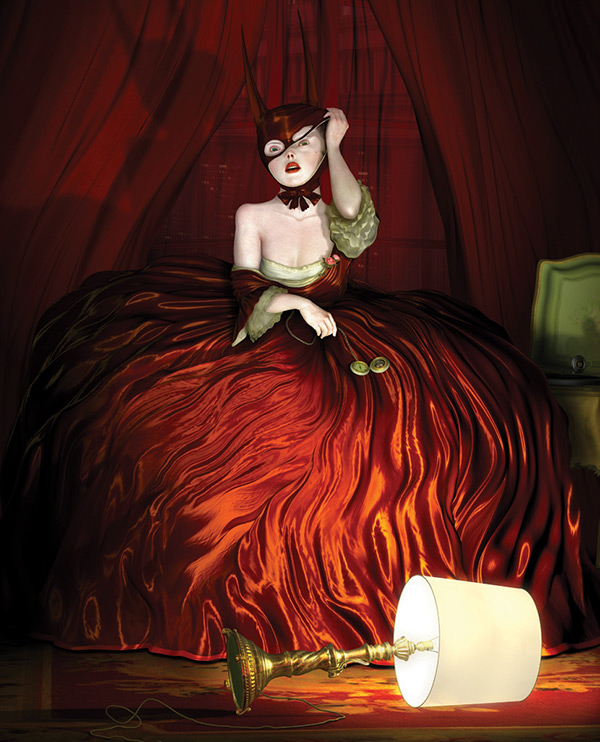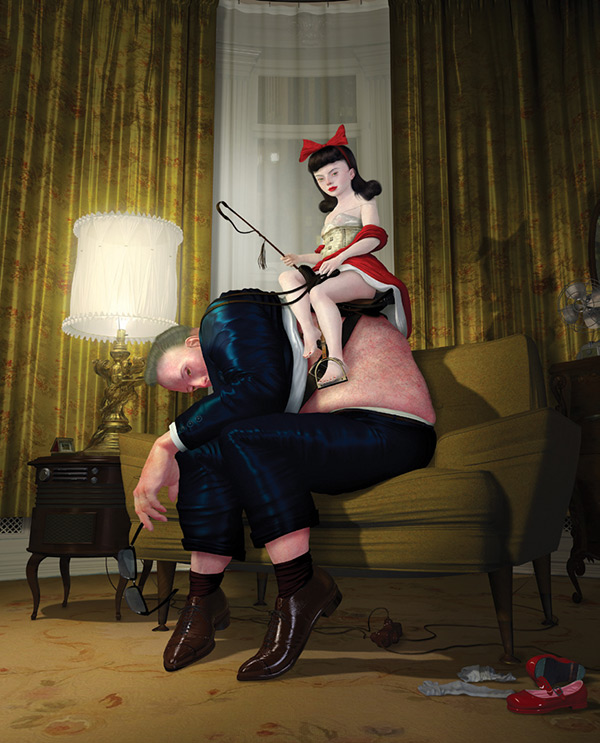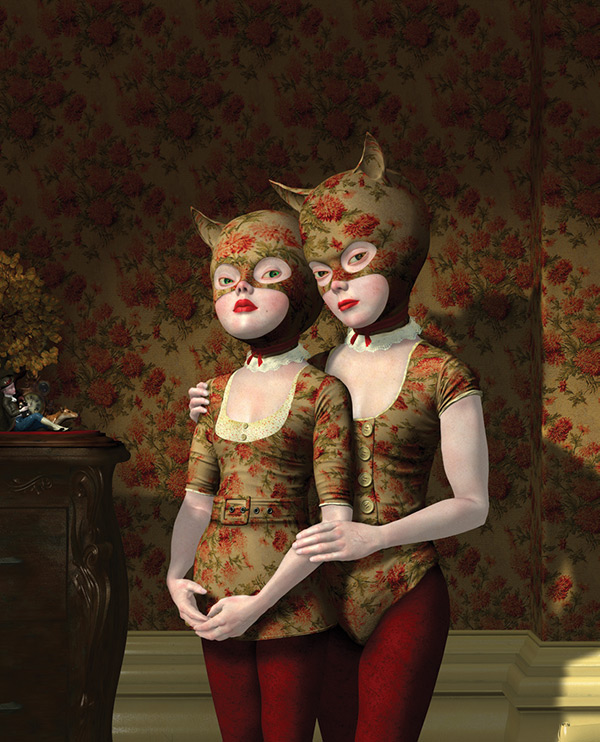
Metatron (2008)
Could you please describe how on earth you create these mesmerising images?
My work is made in a three-dimensional environment using software called Maya. I have used just about every medium in my life and sculpted in a variety of materials; they’re all the same – just tools to bring out the fire in your heart and mind. It doesn’t matter what you use, whether it’s paint or a computer or knitting or building ships out of toothpicks, creation of what you love is the best thing I have found against all the cruel destruction in this world. Use anything but create what you love. There are a lot of ingredients that go into any work of art and I suppose most of them are things that can’t be seen like desire and need, pain and obsession and love and joy and wonder. Those things are just as important as the tools and without them the tools would be useless.
In a sense I guess you might be more aptly described as a sculptor than a painter?
The work is very sculptural but a lot of other things come into play. I originally studied architecture and often I am designing interiors and buildings or I might be poring over references to hairstyles of the 18th century or the 1950s and twisting the curves that create hair into a period style. Lighting and photography come into play as a knowledge of cameras and lights make up an important part of the virtual world. It’s all a bit of everything and even though you see just a still image there truly is a room with a figure and a cabinet – and inside the cabinet there may be hidden things the viewer never sees – but they are there and the unseen things are just as important to me as those things that can be seen.
Do you conceive of the entire scene prior to starting work on it or does it coalesce in the working process?
I usually start off with an idea or a dream or a feeling that I can’t stop thinking about and after starting the process I find that it gradually starts to change into what It wants to be rather than what I had in mind.
It’s a very intuitive and fluid way of working when you can walk around inside your work. Things can change on a whim and in a moment you find yourself working on something that you feel is being directed by someone or something else. It’s not like working on a fixed picture as the point of view can be from anywhere and even when you think it’s about one thing it starts to manipulate you and change into quite another thing entirely. You begin to value the momentary decisions made in your intuitive subconscious rather than being ruled by the planning and fear-based control that the rational conscious mind works by.

Daybreak (2008)
In your experience does a digital environment create more possibilities for the imagination?
If you let that virtual world become another place and if you give it the respect of believing it is another world with its own consciousness and life within it. It’s like giving value to the dreams that are presented by your subconscious mind each night. If you take the time to remember those dreams and give them value, it all enriches your conscious life and you understand more about who and what you really are. The virtual world to me is the same thing as it truly is a universe with its own set of laws and when we work in it we become part of that world. I am only just scratching the surface of what this strange world is all about but it is most assuredly a place where imagination is the key and it most certainly is a place of endless possibilities.
Your work is created through advanced digital technology yet calls to mind the Old Master painters. Are your influences generally contemporary or classical?
I value everything whether it’s from the past or the latest achievement and I don’t value one more than the other. Artists have this tendency to ‘forget’ as each one wants to be original and move beyond the past… but the past holds so many lessons that must be remembered and respected and almost everything of what we call the ‘new’ or what we call ‘original’ is balanced on all that effort from the past….to deny that is a disservice to all those that came before us and set the groundwork from which everything is now created. I don’t think of myself as classical or contemporary; I am just trying to find that elusive feeling that is fleeting and momentary. I know it’s there hiding someplace and it might be in the past or it might be in the future or it might be in some other mysterious place. The joy is in the hunt and all I try to do is create what I love and what I want to see.

side saddle (2008)
Could you please explain the prevalence of deformity in your work?
To me they appear to empower rather than debilitate your subjects.
Deformity was a part of my earlier life with my family as a child and I learnt that there are some deformities that can’t be seen and those that can be seen might not be a deformity at all… it’s a hard thing to explain. Some other aspect of it comes from working seventeen years in a children’s hospital in a photography department that documented all manner of things one might find in one of the largest teaching hospitals in the world. I think we are very different creatures in our spiritual self and made of many different shapes. I think that anyone who has spent some time in the dark quickly loses the idea and concept of what they look like and their ‘shape’ takes on a whole new meaning. Walk around in a dark room and let your hand play along the surfaces of the things you find in there and after a while you might be surprised as not only are the surfaces different but your hand feels different too. When you turn the lights back on there will be a part of you that will understand that the room in the dark is a different place than the room of the light and you are a different creature in both places. It’s like the nature of our conscious and subconscious… think of them like a garden in the day and a garden at night: different creatures and life fill the moonlit garden and dark places appear that weren’t there in the day.
Our shape in our subconscious is not a static thing…. our subconscious shape tends to deform at least from the conscious point of view.
But the subconscious is a very honest part of who we are even if the conscious mind chooses to see it as a deformation and not natural. Which is the real us? Perhaps a deformity is only that because we choose to see it that way. It’s hard to believe you only began exhibiting in your mid-forties.
What was the catalyst that prompted you to share your work with the world?
I suppose over those years I made my work without much interest in showing it as that very act of showing it still unnerves. I never even put it up on my own wall and if anyone came over I would immediately take it down and put it away. It took years for me to make that fragile thing into something and it was a lot like collecting living butterflies – a single touch and they would die. A single criticism or compliment was the same thing; it broke what I was trying to make because I placed too much value in what others thought! So much so that I eventually quit making what I loved. Some years later after a series of deaths within my family and an acceptance of what I can only describe as ‘waking dreams’ or ‘visions’, I was convinced that there was more to this strange life than what is immediately obvious. I decided to show my work and realized that each thing has its time and that the butterfly didn’t die, it deformed, changed into something else. It was much stronger than death itself and it was set free to fly to a place of endless possibilities.

wallflowers (2006)
Interview by Dylan Culhane
Read the rest of issue 12:
Part 2
Click here to view our #FlashBack selection for October.
Click here to view all our #Flashbacks.








